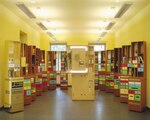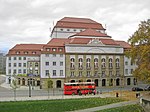Sarrasani is a German circus that reached world fame before World War II and was resident in Dresden, but also became known as the national circus of Argentina during the years of German separation.
Sarrasani was founded by Hans Stosch, a clown with the stage name Giovanni Sarrasani, who was born 1873 in Poznań. Stosch came 1901 to Radebeul near Dresden and the circus had its official premiere 1902 in Meißen. In the year 1912 a stationary circus building opened, which was designed by Max Littmann for Sarrasani. The circus often performed abroad and reached world fame. Its well-known labels were the elephants, but the circus was also known for the Sioux, who were employed from the early years.
From 1923 to 1925 Sarrasani went on its first tour through South America. In these years, Stosch-Sarrasani also introduced innovative marketing concepts and wrote fictive adventure stories Fahrten und Abenteuer, Mit Sarrasani in Südamerika. Totally, about 10 million copies of these booklets were distributed.
After the death of Hans Stosch-Sarrasani Sr., his son Hans Stosch-Sarrasani Jr. took directorship. He was followed by his widow, Trude Stosch-Sarrasani, in 1941. The Sarrasani theater was destroyed on 13 February 1945 during the Bombing of Dresden in World War II. Trude Stosch-Sarrasani emigrated to Argentina, where she reestablished the circus in Buenos Aires as the "Circo Nacional Argentino."
The Argentine writer Gustavo Bernstein tells the story in the book Sarrasani, between the fable and the epic (Biblos, 2000), a fictionalized chronicle in which he accompanies the course of the mythical circus between Europe and America in the context of the sociopolitical events of the last century. The book distinguishes three aesthetic stages in the history of the circus, according to the conduction led by its founder Hans Stosch-Sarrasani (Senior), his son Hans Stoch-Sarrasani son (Junior) or his wife Trude Stoch-Sarrasani.











